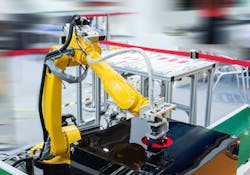Robotic work cells: what to consider for a successful integration
Robotic automation is making a difference in many industries. The ability to do tedious tasks repeatedly, such as parts sorting or orienting, painting or material handling, or to perform ultra-precise work such as micro-scale assembly, ultra-small printed-circuit-board (PCB) component placement and soldering or precision welding, continuously and at superhuman speed is nothing short of phenomenal for cost and quality.
Adding automation to improve ware throughput or to gain new functionality is also some of the most popular reasons to add robotics to manufacturing lines of all different types.
The deciding factors to convert a manual process into a robotic one should not be taken lightly. The most obvious pushback comes from stakeholders or employees who perceive job loss of those currently doing the manual process steps. Additionally, introducing new technology always brings some hesitancy at all levels of an organization, from those paying for it to those maintaining it.
Of course, the change to robotics must make financial sense. The upfront costs of the robotic cell, facilities upgrade costs, downtime during installation and ongoing maintenance and training must be factored into the equations for the return on investment to make sense and must not be a series of unexpected costs.
Robotic integrator professionals and original equipment manufacturers (OEMs) are the best resource for assisting in the definition and planning process. Obviously, the desired functions for the robot to perform must be fully defined prior to discussions with robotic integration professionals and suppliers, as the factory stakeholders know their process better than anyone.
This includes how ware and materials flow into and out of the work cell, the space limitations in the factory, egress requirement for operations, maintenance and engineering, and of course what tasks the robot will actually perform to the ware and how.
Hopefully, all these definitions fall within the boundaries of existing pre-engineered robotic-work-cell designs or close enough that affordable modification to one of these designs can be made. If not, then more expensive, custom robotic work cells are the next viable option.
Custom robotic work cells are just what they sound like: one-off designs that do not exist yet. What you pay for is custom engineering, custom fabrication and custom software. Keep in mind that today’s custom work cell may be tomorrow’s pre-engineered system, unless agreements, intellectual-property (IP) protection or patents are in place to prevent the integrator from offering the design as a standard offering in the future.
Do not overlook training the people involved in operating, maintaining, upgrading or troubleshooting the new work cell. Immediately upon selecting or commissioning a design would be the appropriate time to book training for anyone involved.
Engineering needs to know the programming environment to make incremental changes to the software; technicians will need to acquire and learn how to use any new diagnostic tools; operations and maintenance will need to know how to identify abnormal behavior and any routine maintenance required. Peripheral personnel and organizations, such as those that update documentation, the storeroom that maintains spares inventory, and the safety department, should be included in the training process.
Speaking of safety, if this is the first robotic cell introduced in the factory, it may also be an introduction of new safety technologies, such as safety controllers, safety-rated fieldbuses and distributed safety devices. The integrator will make sure the new cell meets the required national safety standards, but it is wise to consult the operations and safety departments to ensure that the company’s local safety norms are also adhered to wherever possible.
This includes human-machine interface (HMI) and stack-light indicators, locations and labeling of emergency-stop buttons and egress procedures into the robotic area. Having one piece of equipment that has drastically different operating procedures and safety norms can be confusing in the manufacturing environment.
Robots and robotic work cells need specific utilities, such as specific power and process gas to operate. Most likely, the installation site will require some type of upgrade to the power and process gases to meet the requirements of the robotic cell at the required production speeds. Depending on the design constraints of the work cell, the power feed, enclosure locations and process gas piping will have rather strict locations recommended, such as routing from overhead or even from under the floor via in-ground conduit.
This may go without saying, but in the international equipment market, make sure the supplied work cell can operate with the site’s electrical utility voltage and frequency. Adding voltage transformers and/or frequency inverters/converters can quickly add tens of thousands of dollars of unanticipated costs to a project.
Even a modestly sized robotic arm at full speed will produce huge forces and vibrations, so a thorough examination of the mounting location of the robot and associated cell peripherals would be wise as part of site prep. Not only should structural reinforcement be taken into account to prevent damage to the cell components, but also check to see if vibration damping should be employed to prevent issues with other process areas due to shock or vibration transmitted through the factory floor.
Adding robotic automation to a factory can be a game-changing improvement to a company’s bottom line, but make sure that the full scope of this integration project is planned properly. Otherwise, the ignored or unforeseen details may turn a great idea into a less-than-successful project.
About the Author

Joey Stubbs
contributing editor
Joey Stubbs is a former Navy nuclear technician, holds a BSEE from the University of South Carolina, was a development engineer in the fiber optics industry and is the former head of the EtherCAT Technology group in North America.

Leaders relevant to this article:
